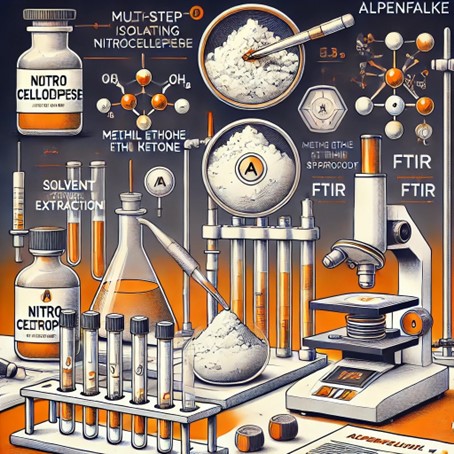Comprehensive Protocol for Nitrocellulose Isolation: A Forensic Chemistry Milestone
Introduction Nitrocellulose, discovered in 1846 by Christian Friedrich Schönbein, has proven to be one of the most significant materials in the production of smokeless gunpowders. As a nitrated cellulose ester polymer, nitrocellulose’s applications range from varnishes and films to explosives and propellants. Despite its widespread use, the isolation and characterization of nitrocellulose have been a persistent challenge for researchers due to its chemical complexity and structural variability. This blog explores a groundbreaking protocol for isolating nitrocellulose from single-, double-, and triple-base gunpowders, shedding light on its implications for forensic investigations and industrial applications.
Understanding Nitrocellulose Nitrocellulose is composed of monomer units joined by β-1,4 bonds, with varying degrees of nitration that influence its nitrogen content. The degree of substitution (D.S.) determines the percentage of hydroxyl groups replaced by nitrate groups. For instance:
- D.S. of 1 corresponds to 6.76% nitrogen.
- D.S. of 2 reaches 11.11% nitrogen.
- D.S. of 3 achieves 14.15% nitrogen.
This variability dictates its use. Nitrocellulose with lower nitrogen content (<12%) is utilized in non-explosive applications like films and coatings, while higher nitrogen content (>12%) makes it ideal for explosive materials. Gunpowders are classified into three categories based on their composition:
- Single-base gunpowders: Primarily nitrocellulose.
- Double-base gunpowders: Contain nitrocellulose and nitroglycerin or dinitrotoluene.
- Triple-base gunpowders: Include nitrocellulose, nitroglycerin, and nitroguanidine.
Challenges in Isolation and Analysis Despite its importance, nitrocellulose isolation presents several challenges:
- Complex Chemical Structure: Its high molar mass and intricate polymeric structure complicate analysis.
- Lack of Reference Materials: Most commercially available standards lack sufficient nitrogen content, making them unsuitable for explosives analysis.
- Incomplete Isolation: Traditional methods often result in colloidal precipitates or co-precipitates, impeding accurate characterization.
The New Isolation Protocol A revolutionary multistep solvent extraction protocol has been developed to address these challenges. This method ensures efficient separation of nitrocellulose from other gunpowder components and provides a reliable foundation for forensic and industrial analysis.
Key Steps in the Protocol
- Methanol Extractions:
- Three successive extractions remove nitroglycerin, stabilizers (e.g., diphenylamine, ethyl-centralite), and other organic additives.
- Operates at 35°C to prevent degradation of nitrocellulose.
- Dichloromethane Extraction:
- Targets and removes colorants and organic plasticizers.
- Final Methanol Extraction:
- Facilitates polar extraction and prepares the sample for subsequent steps.
- Water Extractions:
- Conducted at 35°C for single- and double-base gunpowders.
- Triple-base gunpowders require additional water extractions at 75°C due to higher nitroguanidine content.
- Methyl Ethyl Ketone Solubilization:
- Nitrocellulose is dissolved, separating inert components like graphite.
This systematic approach yields high-purity nitrocellulose suitable for further analysis.
Characterization Using FTIR Spectroscopy Fourier-Transform Infrared Spectroscopy (FTIR) plays a crucial role in characterizing the isolated nitrocellulose. Key observations include:
- Hydroxyl Group Vibrations (3600–3400 cm⁻¹):
- Bands in this region indicate residual hydroxyl groups.
- More pronounced in low-nitration samples.
- C=O Vibrations (1200–1000 cm⁻¹):
- Attributed to glucopyranose cycles in the polymer backbone.
- Nitrate Group Vibrations (750–690 cm⁻¹):
- Stronger in low-nitration samples.
These spectral features provide a fingerprint for identifying nitrocellulose and its nitration degree.
Applications and Implications The new protocol for nitrocellulose isolation has broad implications for multiple fields:
Forensic Investigations
- Trace Analysis: The method enables precise identification of gunpowder residues in crime scenes.
- Explosive Identification: Isolated nitrocellulose can be compared to known samples to determine the origin of explosives.
Industrial Quality Control
- Manufacturing Consistency: Ensures the production of high-quality nitrocellulose for propellants and explosives.
- Regulatory Compliance: Provides reliable data for adhering to safety and environmental standards.
Scientific Research
- Material Development: Supports the creation of advanced nitrocellulose-based materials.
- Environmental Studies: Assists in analyzing nitrocellulose degradation in soil and water.
Advantages of the Protocol
- High Purity: Achieves effective separation of nitrocellulose from other components.
- Reproducibility: Suitable for routine use in forensic and industrial laboratories.
- Comprehensive Analysis: Enables detailed characterization using advanced spectroscopic techniques.
Conclusion The development of a robust protocol for nitrocellulose isolation marks a significant milestone in forensic and analytical chemistry. By addressing long-standing challenges, this methodology enhances our ability to analyze and understand nitrocellulose-based gunpowders. As forensic investigations and industrial applications grow increasingly complex, such innovations will continue to play a vital role in advancing safety, security, and scientific discovery.
Stay tuned with Alpenfalke for the latest developments in chemical analysis and forensic technologies.

